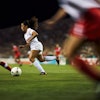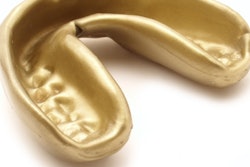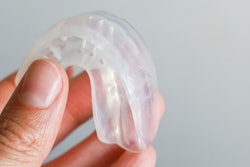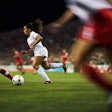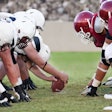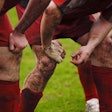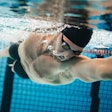
Wearing mouthguards may do more than protect athletes' teeth. Athletes who wear mandible-controlled mouthguards may experience enhanced physical performance, according to a new study published November 5 in the journal Injury.
Athletes who wear controlled-mandible-position mouthguards may experience increases in peak force and acceleration while performing ballistic bench press throws. The mouthguard places the jaw in centric relation (CR), defined as a position in which the head of the condyle sits as far posterior and inferior as possible, the authors wrote.
"To our knowledge, this is the first study investigating how mouthguards placing the mandible in CR may affect strength and power in trained athletes," wrote the authors, led by Dr. Amandio Dias of the Laboratory of Human Movement Analysis at the Piaget Institute in Portugal.
Though mouthguards are effective in preventing injuries while playing sports, their effects on strength and power remain controversial. Past studies have suggested that using mouthguards may create a high vertical increase in dental occlusion that may influence muscle activity and force production in the upper body.
Also, changes in the way teeth make contact can cause significant effects on body mechanics. Therefore, changes in the temporomandibular joint may affect other muscles in the body, and researchers wanted to further explore this phenomenon.
To determine whether controlled-mandible-position mouthguards affect strength and power production in trained athletes, 22 seasoned male rugby players performed bench press throws. They all had experience performing resistance training and had no temporomandibular joint disorders, the authors wrote.
The men exercised with the following: no mouthguards, over-the-counter controlled-mandible mouthguards, over-the-counter uncontrolled mouthguards, and occlusal splints. The players were assessed for several variables, including velocity, power, peak acceleration, and peak force, and the results underwent statistical analyses, according to the study.
When wearing controlled mouthguards, athletes demonstrated a significantly higher peak acceleration and peak force than those who wore no mouthpieces, the authors wrote.
| Impact of mandible-controlled mouthguards on ballistic bench throws | ||
| Performance variable | No mouthguard | Controlled mouthguard |
| Peak acceleration (m/second2) | 10.317 ± 2.45 | 11.294 ± 3.56 |
| Peak force (N) | 883.25 ± 187.81 | 929.18 ± 243.89 |
However, no significant differences were seen among the other conditions and variables, they wrote.
Nevertheless, the study had a limitation. Past evidence has shown that clenching while wearing a mouthguard may have a positive effect on sports performance. Since the athletes were not instructed on how to clench their jaw during bench press throws, and biting force data were not collected, researchers cannot exclude the possibility that clenching may have affected their performance, they wrote.
Besides protecting the teeth and preventing facial injury, mouthguards may have some positive ergogenic effects, they wrote.
"Therefore, these results encourage athletes to use mandible-controlled position mouthguards, since upper body ballistic movements are involved in a variety of sports skills and tasks," Dias and colleagues concluded.

